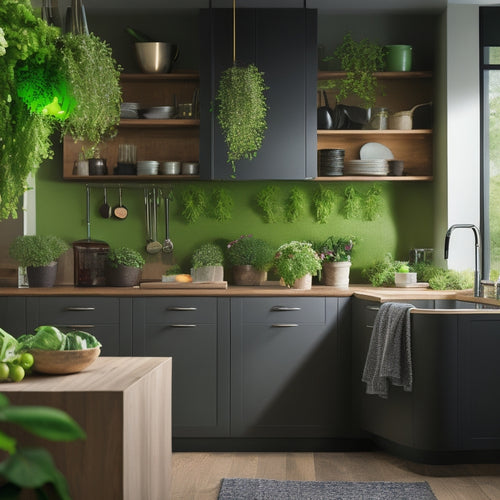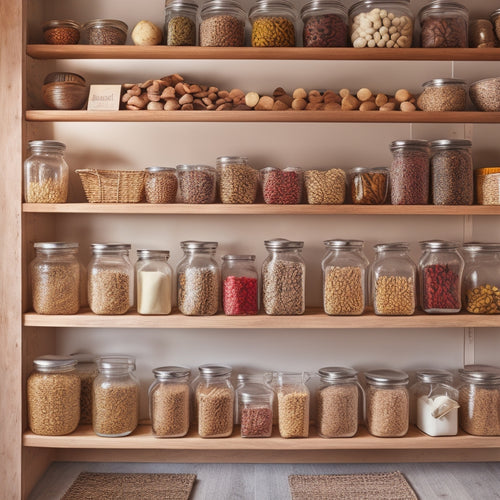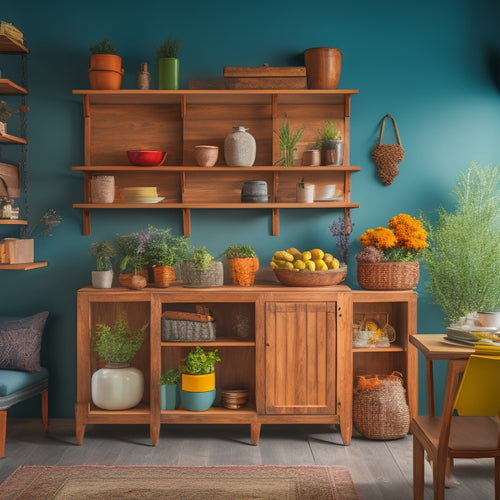
Organize Utensils With Custom Kitchen Drawer Dividers
Share
You can revolutionize your utensil storage by designing a custom kitchen drawer divider system. Start by measuring your drawer's interior dimensions, accounting for obstructions and ensuring a snug fit. Choose a durable, eco-friendly material that fits your style and kitchen traffic. Then, categorize your utensils by function, frequency of use, and size, assigning each a designated spot. Consider adjustable dividers, tiered compartments, and stacked baskets to maximize storage. With a tailored system, you'll boost productivity, reduce stress, and enjoy easy access to your utensils. Now, take the next step to create a seamless utensil organization system that works perfectly for you.
Key Takeaways
• Custom drawer dividers help boost productivity and reduce stress by providing control and organization in kitchen utensil storage.
• Measure kitchen drawer space accurately to ensure a snug fit for custom dividers that maximize storage capacity and accessibility.
• Choose a divider material that is durable, eco-friendly, and reflective of personal style to enhance kitchen aesthetics and functionality.
• Assign homes for utensils based on categories, frequency of use, size, and shape to prevent clutter and accidents in the kitchen drawer.
• Install and maintain custom dividers with precision to ensure a comfortable fit, easy access, and spatial efficiency in utensil storage.
Benefits of Custom Drawer Dividers
Optimizing your kitchen drawers with custom dividers can greatly boost your productivity and reduce stress by providing a sense of control and organization over your cooking space.
With custom dividers, you can create a space that's tailored to your specific needs, ensuring that everything has its designated spot.
This leads to customized efficiency, where you can quickly find what you need, when you need it.
Measuring Your Kitchen Drawer Space
Take out your tape measure and carefully record the interior dimensions of your kitchen drawers, including the width, depth, and height, to guarantee your custom dividers fit snugly and maximize storage capacity. This step is essential for effective drawer organization and space utilization.
Here's a breakdown of what you should measure:
| Drawer Dimension | Measurement |
|---|---|
| Width | From one side of the drawer to the other |
| Depth | From the front of the drawer to the back |
| Height | From the top of the drawer to the bottom |
When taking these measurements, make sure to account for any obstructions, such as drawer slides or handles. You want your custom dividers to fit seamlessly, without any gaps or overlaps. Remember to record your measurements accurately, as this will guarantee a perfect fit for your dividers. By doing so, you'll be able to create a tailored drawer organization system that makes the most of your available space.
Choosing the Right Divider Material
When selecting a material for your custom kitchen drawer dividers, you'll want to contemplate a few key factors.
You'll need to ponder how durable the material needs to be, depending on how heavily you'll be using the dividers.
You'll also want to reflect on the style you're aiming for, as well as any eco-friendly alternatives that might fit the bill.
Material Durability Matters
Your custom kitchen drawer dividers will be subjected to daily wear and tear, so choosing a material that can withstand the rigors of frequent opening, closing, and storing is crucial. You want a material that guarantees longevity and can resist scratches, cracks, and breaks.
Here's a comparison of popular materials for custom kitchen drawer dividers:
| Material | Durability |
|---|---|
| Wood | High |
| Plastic | Medium |
| Bamboo | High |
When considering material durability, think about your kitchen's traffic and usage. If you have a large family or entertain frequently, you may want to opt for a more durable material like wood or bamboo. These materials can withstand heavy use and are less likely to show signs of wear. On the other hand, if you live alone or have a small kitchen, plastic dividers might be sufficient. Additionally, consider customization options that can enhance durability, such as adding a protective coating or finish. By selecting the right material, you can ensure your custom kitchen drawer dividers remain functional and safe for years to come.
Divider Style Options
Beyond durability, the style of your custom kitchen drawer dividers plays a significant role in organizing your kitchen utensils and tools efficiently. You want dividers that not only keep your kitchen organized but also fit your personal style and kitchen aesthetic.
When choosing a divider style, you'll have various design options to explore. You can opt for custom finishes that match your kitchen cabinets or countertops, creating a seamless look. Adjustable dividers are also a great choice, allowing you to customize the layout of your drawer as your needs change.
If you want to add a touch of personality to your kitchen, explore decorative styles like wooden or metal dividers with intricate designs. These can add a unique element to your kitchen while still keeping your utensils organized. Additionally, you can choose dividers with built-in features like utensil holders or spice racks to maximize storage space.
Whatever style you choose, make sure it's one that works for you and your kitchen. With the right divider style, you'll be able to find what you need quickly and easily, making cooking and meal prep a breeze.
Eco-Friendly Alternatives Exist
As you select the perfect divider style, you're likely contemplating the material it's made of, which is where eco-friendly alternatives come in, offering a responsible way to organize your kitchen while reducing your environmental footprint. Eco-friendly materials are a great way to guarantee your kitchen stays organized while also being sustainable.
Here are some eco-friendly material options to explore:
| Material | Sustainability Benefits | Durability |
|---|---|---|
| Bamboo | Renewable resource, low carbon footprint | High |
| Recycled Plastic | Reduces waste, conserves natural resources | Medium |
| FSC-Certified Wood | Sustainably sourced, reduces deforestation | High |
When choosing eco-friendly materials, make sure to research the manufacturer's sustainability practices and certifications. Look for materials that are sturdy and long-lasting to guarantee your dividers stay effective for years to come. By opting for sustainable options, you'll not only be organizing your kitchen but also doing your part for the environment.
Designing a Utensil Storage System
When designing a utensil storage system, you'll want to start by categorizing your utensils based on frequency of use, size, and type. This will help you determine the best layout for your drawer, ensuring that the most accessible space is allocated to your most-used items.
Utensil Categorization Strategy
You'll need to categorize your utensils into groups based on their function, frequency of use, and physical characteristics to design an effective utensil storage system. This pivotal step will help you optimize your kitchen space and enhance efficiency.
To begin, sort your utensils into categories such as cooking, baking, and serving. Then, further divide each category into subgroups based on frequency of use, with daily use items separated from occasional use items.
| Category | Subcategory | Utensils |
|---|---|---|
| Cooking | High-Frequency | Spatulas, Whisk, Tongs |
| Cooking | Low-Frequency | Meat Thermometer, Garlic Press |
| Baking | High-Frequency | Measuring Cups, Spoons, Electric Mixer |
| Baking | Low-Frequency | Cake Tester, Pastry Brush |
Optimal Drawer Layout
Now that you've categorized your utensils, it's time to assign them a home in your kitchen drawer, where a well-designed layout will guarantee each item is easily accessible and efficiently stored.
To achieve ideal drawer organization, start by measuring the interior dimensions of your drawer. Consider the size and shape of each utensil category, and allocate space accordingly. For example, reserve the back of the drawer for infrequently used items, like special occasion utensils, and allocate the front for daily essentials, like forks and knives.
To maximize space efficiency, group similar utensils together, such as all cutting tools or all serving spoons. This will prevent clutter and make it easier to find what you need.
Consider the 'golden zone' – the area between your waist and shoulder height – and place frequently used items within this range to minimize straining and bending.
Creating a Utensil Categorization Plan
Six essential categories will help you organize your utensils in a logical and functional way. These categories will form the foundation of your utensil organization plan, making it easier to find what you need when you need it.
The first category is baking utensils, which includes items like whisks, spatulas, and pastry brushes.
Next, you'll have cooking utensils, such as spoons, tongs, and chef's knives.
The third category is dining utensils, which consists of forks, knives, and spoons.
You'll also have a category for kitchen tools, like can openers, garlic presses, and kitchen shears.
The fifth category is prep utensils, including items like peelers, graters, and mandolins.
Finally, you'll have a miscellaneous category for items that don't fit into the other groups.
Assigning a Home for Each Utensil
Sort your utensils into their designated categories, and then determine the most accessible and convenient spot within your tailored kitchen drawer dividers for each item. This step is essential in achieving best utensil organization and space efficiency.
Consider the frequency of use, size, and shape of each utensil when assigning its home. For example, place your most frequently used items in easy-to-reach areas, and reserve the back or bottom sections for less-used items.
As you assign a home for each utensil, keep in mind the custom dividers' design and layout. Ensure that each item fits snugly in its designated space, preventing clutter and overcrowding.
This decluttering solution won't only save you time and energy but also reduce the risk of accidents caused by utensils falling or getting tangled.
Maximizing Vertical Drawer Space
To optimize your custom kitchen drawer dividers, consider installing tiered or stacked compartments that take advantage of the vertical space, allowing you to store more items without sacrificing accessibility. This will help you make the most of your drawer's vertical storage capacity, keeping your utensils organized and within reach.
Here are some space-saving techniques to maximize your vertical drawer space:
| Technique | Description | Benefits |
|---|---|---|
| Tiered Compartments | Separate compartments stacked on top of each other | Increased storage capacity, easy access to items |
| Stacked Baskets | Baskets placed on top of each other | Visibility of contents, prevents clutter accumulation |
| Adjustable Dividers | Dividers that can be adjusted to fit different utensil sizes | Flexibility, adapts to changing storage needs |
| Vertical Slots | Narrow slots for storing long utensils like spatulas and whisks | Efficient use of vertical space, easy retrieval |
| Stackable Trays | Trays that can be stacked on top of each other | Organization, visibility, and easy access to items |
Using Dividers for Utensil Grouping
By grouping similar utensils together using custom dividers, you can create zones within your kitchen drawer that make it easy to find what you need when you need it. This utensil organization hack not only saves you time but also promotes spatial efficiency in your drawer.
Here are three ways to group your utensils effectively:
-
Categorize by Function:
Divide your utensils into categories like baking, cooking, and serving. This way, you can access the tools you need for a specific task quickly. -
Color Code Utensils:
Use dividers with different colors to separate utensils based on their material, such as metal, wood, or silicone. This visual distinction makes it easy to locate a specific utensil. -
Prioritize Frequently Used Items:
Place your most frequently used utensils in the front and center of the drawer, making them easily accessible. This drawer organization tip guarantees you can grab what you need without having to dig through the entire drawer.
Customizing for Unique Utensil Shapes
When customizing your kitchen drawer dividers, you'll need to take precise measurements of your unique utensils to guarantee they fit comfortably in their designated compartments.
You'll want to contemplate the length, width, and height of each item to optimize the layout of your dividers.
Utensil Measurement Matters
You'll want to think about the unique shape and size of each utensil in your collection, as customizing your drawer dividers to fit these unusual shapes will guarantee they're stored efficiently and easily accessible.
This is important for effective utensil organization, as it ensures that each item has its own designated space, preventing clutter and reducing the risk of damage.
To get started, take inventory of your utensils and identify those with unique shapes or sizes. Then, consider the following factors when customizing your drawer dividers:
-
Width and depth: Measure the width and depth of each utensil to determine the best divider size.
-
Height and angle: Consider the height and angle of each utensil, as some may require dividers with adjustable heights or angled compartments.
-
Specialized storage: Think about utensils that require specialized storage, such as sharp knives or delicate spatulas, and design dividers that cater to their specific needs.
Optimal Compartmentalization Strategies
With your utensil measurements in hand, it's time to develop a customized compartmentalization strategy that accommodates the unique shapes and sizes of each item, ensuring a precise fit that maximizes storage efficiency.
This means creating separate compartments for utensils with distinct profiles, such as whisks, spatulas, and tongs. For example, you might design a narrow, vertical compartment for your longest utensils, like a chef's knife or a pastry brush.
Meanwhile, shorter, wider utensils, like a garlic press or a stand mixer paddle, can be stored in a separate, horizontally divided compartment.
Installing and Maintaining Dividers
How do you secure a seamless integration of your custom kitchen drawer dividers into your existing storage space? The answer lies in proper installation and maintenance. A well-planned installation secures your dividers fit snugly and don't obstruct the drawer's functionality.
Here are some essential tips to keep in mind:
-
Measure twice, install once: Double-check your measurements to secure a precise fit.
-
Secure the dividers: Use screws, adhesive, or other recommended fastening methods to prevent the dividers from shifting or toppling over.
-
Leave space for adjustment: Allow a small margin for future adjustments or changes in your utensil collection.
Frequently Asked Questions
Can I Use Custom Dividers in Pre-Existing Kitchen Drawers?
You can easily customize your existing kitchen drawers with dividers, maximizing space and functionality while ensuring safety. Simply measure your drawers, choose the right materials, and install dividers that fit your specific drawer organization needs.
How Do I Clean and Maintain Custom Kitchen Drawer Dividers?
You'll extend the life of your custom dividers by regularly wiping them down with a damp cloth and mild soap, and drying thoroughly to prevent water spots, ensuring longevity maintenance and a clean, safe kitchen environment.
Are Custom Dividers Suitable for All Types of Kitchen Utensils?
Imagine a harmonious orchestra, where each instrument has its perfect place. Similarly, you'll find that custom dividers aren't a one-size-fits-all solution; they're ideal for most utensils, but may not accommodate oversized or irregularly shaped items, requiring careful consideration for best drawer space organization.
Can I Customize Dividers to Fit Specific Kitchen Utensil Sizes?
You can definitely customize dividers to fit specific kitchen utensil sizes, ensuring perfect utensil organization and maximizing drawer customization for enhanced kitchen efficiency, while keeping your kitchen safe and organized.
Do Custom Dividers Work Well in Small or Narrow Kitchen Drawers?
You'll be amazed at how custom dividers can magically transform even the tiniest kitchen drawers into space-saving solutions! By designing a thoughtful drawer layout, you'll reap the benefits of custom dividers, maximizing storage and ensuring a safe, clutter-free cooking environment.
Related Posts
-

Rechargeable Under-Cabinet Lighting for Sustainable Kitchens
Rechargeable under-cabinet lighting is ideal for your sustainable kitchen. You'll enjoy energy efficiency with LED te...
-

Innovative Pantry Storage Ideas for Homes
Revamp your pantry into an efficient space with innovative storage solutions. Use vertical storage options like ceili...
-

Creative Corner Cabinet Space Management
Creative corner cabinet space management turns neglected nooks into stunning storage solutions. You can maximize vert...


